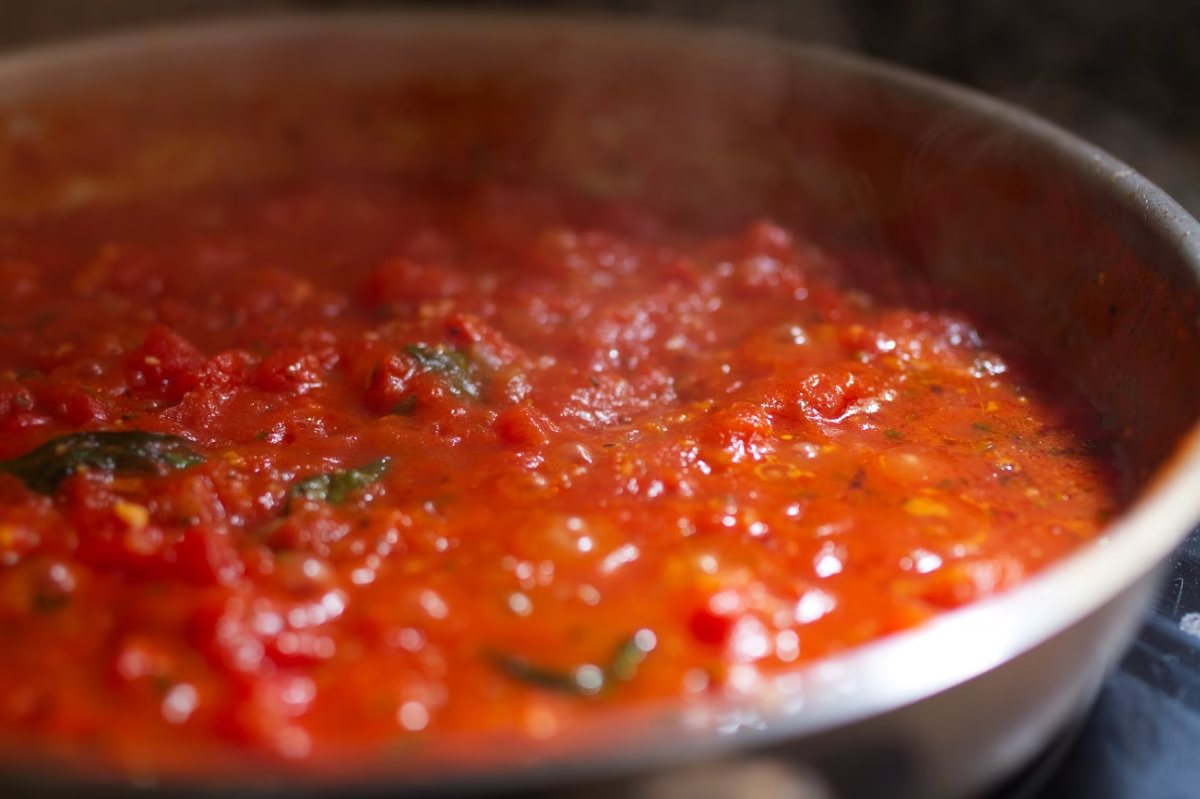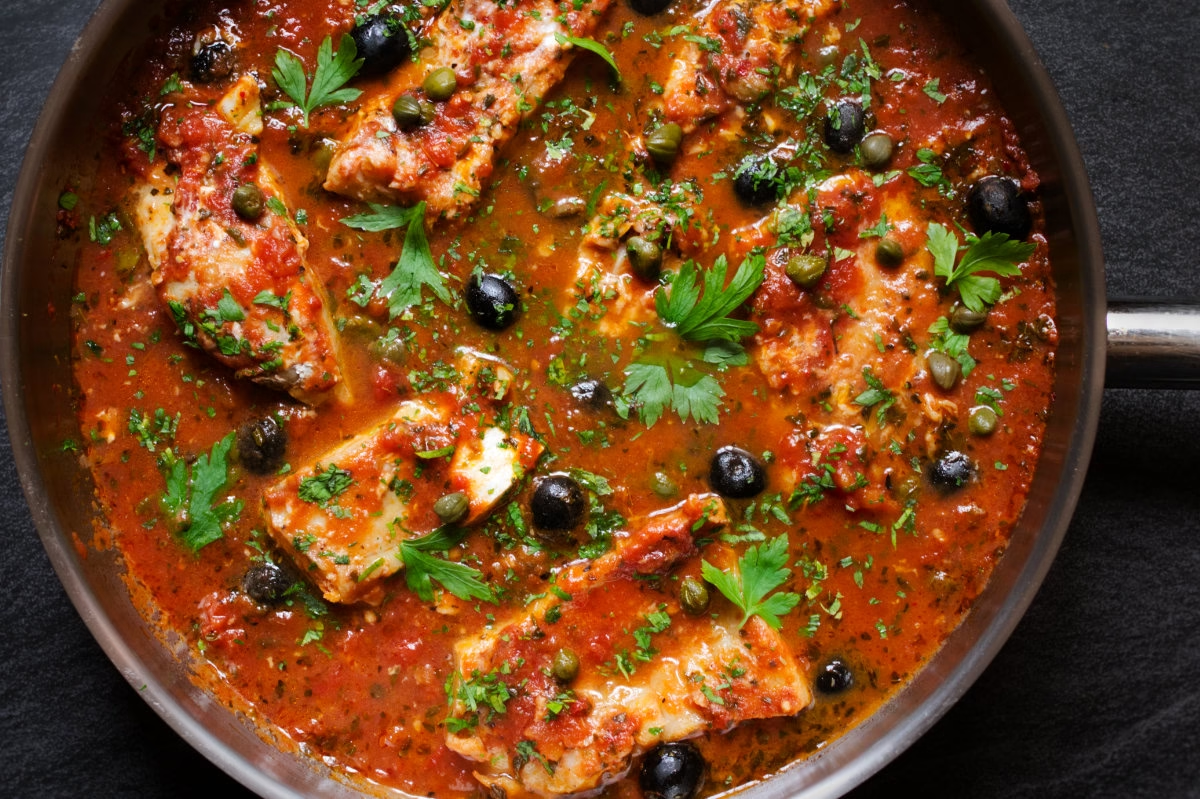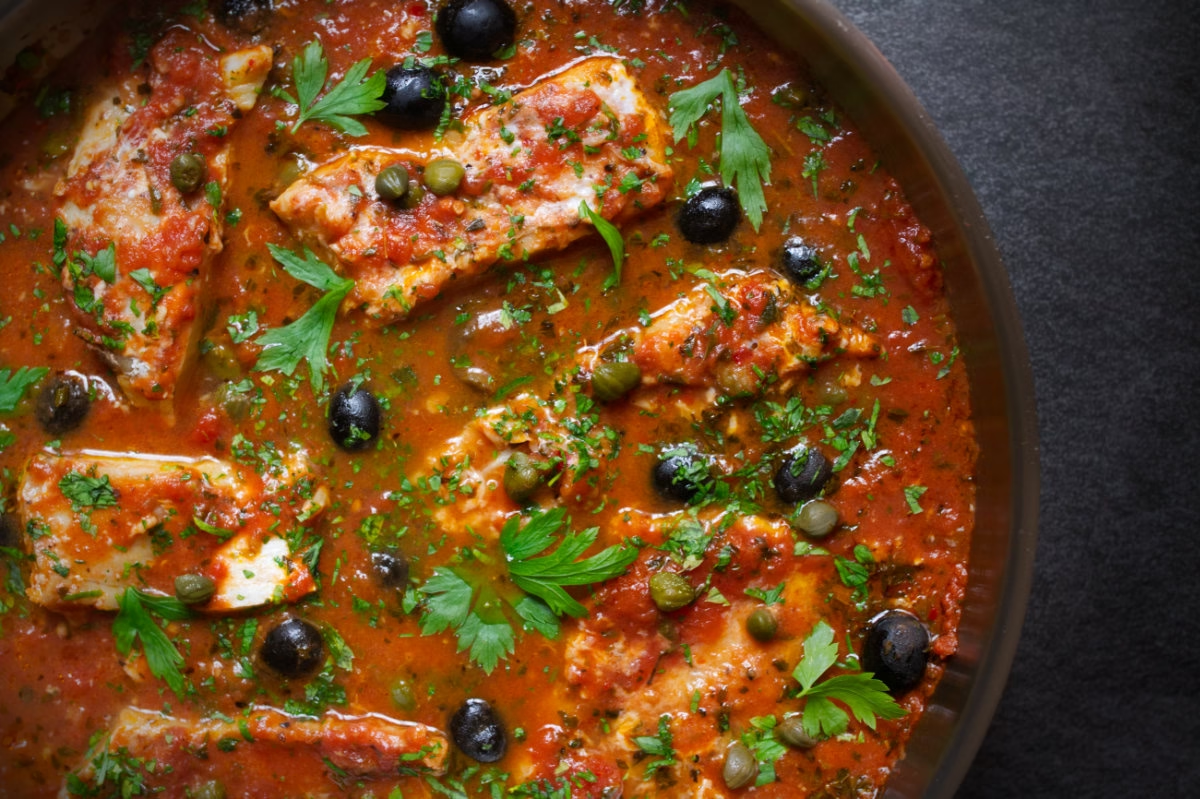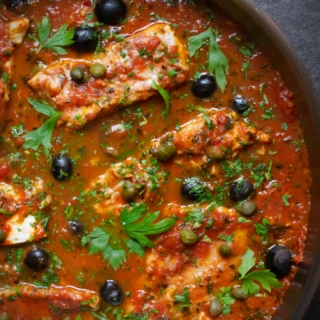Fish puttanesca is a fantastic twist on the classic Italian pasta dish and also our Chicken Puttanesca version that was super popular!
This recipe is perfect for when you’re craving something cozy, flavorful, and effortlessly impressive, this Fish Puttanesca is sure to become your new weeknight go-to. Inspired by the classic Italian pasta dish, this recipe swaps spaghetti for tender white fish simmered in a rich tomato sauce loaded with garlic, olives, capers, and anchovies.
It’s a one-pan wonder that’s full of briny, zesty Mediterranean flavor — the kind of meal that feels gourmet but comes together in under 45 minutes.
Serve it with pasta, rice, or just a hunk of crusty bread to soak up every last drop of that delicious sauce. This recipe makes 4 servings.
Italian | Main | Fish | Anchovy | Sauce
Table of contents:
- How to Make Fish Puttanesca
- Ingredients
- Origin of Puttanesca Sauce
- Equipment
- Tomatoes to use for Puttanesca Sauce
- Which Anchovies Work Best in Fish Puttanesca
- What to Do if Puttanesca Sauce is Too Briney or Salty
- FAQs

How to Make Fish Puttanesca
Ingredients
- 4-6 fillets of white fish (100-150g per fillet)
- 2 tsp Dried Oregano or Italian seasoning
- Extra Virgin Olive Oil
- 1 lemon, juiced
- 4-8 anchovy fillets in olive oil (see notes below on what anchovies to use)
- 5-6 garlic cloves, minced
- 1 (28-ounce) can whole peeled tomatoes (ideally San Marzano tomatoes if you can find them)
- ½ cup pitted black Olives (Kalamata or similar)
- 2 Tbsp Capers, with brine
- ½ cup fresh parsley leaves (or basil), for garnish
- Salt and Pepper, to taste
- 1 tsp Chili pepper flakes (optional)
Equipment
- Ceramic Garlic Grater Plate
- Chef Knife
- Cooking tongs
- Wooden Cutting Board
- Meat thermometer
- Lemon Juicer
- 12-Inch Stainless Steel Frying Pan
- Wooden spatula

Instructions
Step 1 – Season the Fish
- Cut the fillets into large slices then season on all sides with a little salt, pepper and a little olive oil.
- Cover and return to the fridge for use later.
- Note: If using frozen fish, thaw the fish and pat dry then season with salt and pepper only to draw out any excess liquid.
Step 2 – Make the Puttanesca Sauce
- Heat some oil in a large deep sided skillet ot pan on medium heat.
- Add the garlic and cook for 2 minutes or until fragrant, then add the olives, capers and anchovies. If using chili flakes, add them now and stir through.
- Use a wooden spatula to break apart the anchovies and then stir into the other ingredients.
- Add the whole tomatoes (and juice) and 1 tsp of oregano. Break the tomatoes apart with a spatula and stir through.
- Bring to a simmer and cook for around 20 minutes.
Step 3 – Add the Fish Fillets
- Add the fillets to the pan and spoon some sauce over the top of each piece.
- Add a squeeze of fresh ñemon juice, some caper juice, and sprinkle a few capers around the fillets.
- Reduce heat to medium-low and cook for another 10–12 minutes, until the fish is cooked and starting to flake.
Step 4 – Garnish & Serve
- Garnish with some fresh chopped parsley or a little fresh basil.
- Serve hot straight from the pan alongside some pasta, rice, or crusty bread to soak up the delicious sauce.

Origin of Puttanesca Sauce
Puttanesca sauce — known in Italian as sugo alla puttanesca — comes from southern Italy, most often linked to Naples (though some say it started in Rome). It’s a bold, rustic sauce made with simple pantry staples: tomatoes, garlic, olives, capers, and anchovies.
The name “puttanesca” literally translates to “in the style of the ladies of the night,” and that’s where the stories often get colorful. One popular theory says the sauce was invented by Neapolitan women who worked late and needed a quick, fragrant meal they could make from what they had on hand — inexpensive ingredients that didn’t spoil easily.
Another version suggests the name came from the tempting aroma of the sauce, said to be so enticing it could lure people in from the streets!
No matter which story you believe, spaghetti alla puttanesca became a staple of Italian home cooking — a dish that’s bold, briny, and unapologetically full of flavor.
More Italian Sauce Recipes:

Best Fish to Use
As the Puttanesca sauce has some strong briney flavors from the tomatoes, olives, and capers, you need to use a fish that can stand up to those assertive ingredients without falling apart.
Any thick fillet of white fish will work well for this recipe. Fresh or frozen both work fine, just make sure to thaw frozen fish fillets and then season the fish with salt to draw out excess liquid. For this recipe we used frozen cod fish fillets. They are a readily available option and aren’t too expensive.
Here are some excellent fish options for puttanesca, depending on your texture and flavor preferences:
Firm, meaty white fish (best all-around choices)
These hold their shape well and absorb the sauce beautifully:
- Cod (Atlantic or Pacific) – Mild, flaky, but firm enough for sauce braising.
- Halibut – Buttery and firm; slightly sweet flavor balances the salty sauce.
- Swordfish – Dense and meaty; pairs perfectly with the bold, tangy sauce.
- Mahi-mahi – Mild and firm, with a slightly tropical flavor.
- Monkfish – Called “poor man’s lobster” — very firm and holds up great.
Rich, oily fish (for extra depth and Mediterranean flavor)
These complement the anchovy/olive base really well:
- Tuna (fresh or thick steaks) – Grilled or seared, then served with the sauce spooned over.
- Mackerel – Strong flavor that works well with olives and capers.
- Sardines – Traditional in some Southern Italian versions; use fillets for ease.
Fish Cooking Tips
- Poach the fish gently in the simmering sauce for the last 8–10 minutes — especially good for cod or halibut.
Add fresh herbs (parsley, basil) and a squeeze of lemon at the end to brighten it all up.

Tomatoes to use for Puttanesca Sauce
For puttanesca, the tomatoes are the backbone of the sauce—so the variety really matters. If there’s one ingredient to spend some time hunting down, it’s some good quality tomatoes.
Italians reach for San Marzano tomatoes, prized for their naturally sweet flavor, low acidity, and meaty texture.
Here are the best options:
Cento Certified San Marzano Whole Peeled Tomatoes, 28 Oz (Pack of 6)
Muir Glen Organic Diced Canned Tomatoes, 28 oz.
Mutti Whole Peeled Tomatoes (Pelati), 28 oz. | 6 Pack
Crushed tomatoes (shortcut): A convenient option if you want a smoother sauce without blending whole tomatoes yourself.
San Marzano (best choice): Grown in Italy’s Campania region, these tomatoes are D.O.P.-certified and considered the gold standard. They break down into a silky, balanced sauce.
Whole peeled canned tomatoes: If San Marzano isn’t available, choose a high-quality brand of whole peeled tomatoes (like Cento, Muir Glen, or Mutti). Whole tomatoes tend to be less processed than diced or crushed, giving you more control over texture.
Fresh ripe plum or Roma tomatoes: Great in summer when tomatoes are at their peak. They’ll need to be peeled and simmered longer to achieve the same depth as canned.

Which Anchovies Work Best in Fish Puttanesca
Anchovies are what give fish puttanesca that rich, savory flavor everyone loves. Don’t worry — they don’t make the dish taste “fishy.” Instead, they melt right into the sauce and add a deep, delicious umami kick.
Here are your best options:
1. Anchovy Fillets in Oil (the classic choice)
These are the easiest and most common type to use. They quickly dissolve into the sauce, leaving behind tons of flavor. Try to grab a good-quality brand from Italy or Spain — you’ll really taste the difference.
2. Salt-Packed Anchovies (for extra punch)
These come packed in salt and have a stronger, more intense flavor. You’ll need to rinse and fillet them before using. They’re amazing if you want a bolder taste, but remember — they’re saltier than the oil-packed kind.
3. Anchovy Paste (super easy option)
If you don’t want to deal with fillets, anchovy paste is your best friend. Just squeeze in a bit at a time until it tastes right.
💡 Quick Tip:
Anchovies, olives, and capers are all naturally salty, so go easy on the salt when seasoning your fish. Taste the sauce before adding any extra — that way, you get all the flavor without overdoing it.

What to Do if Puttanesca Sauce is Too Briney or Salty
a too-briny puttanesca can happen easily, since you’ve got anchovies, capers, and olives all bringing salt and intensity to the party. Luckily, it’s easy to fix without losing the sauce’s character.
Here’s what to do, step-by-step 👇
🧂 1. Balance and dilute the saltiness
- Add unsalted crushed tomatoes or tomato purée — This is the best fix. Stir in ½ to 1 cup, simmer a few minutes, and taste again. It stretches the sauce and mellows the salt.
- Add a splash of water, white wine, or low-sodium stock — Loosens the sauce and lightens the brine. Simmer briefly to integrate.
- Don’t add salt until the very end (or at all) — Remember, the fish or pasta will bring some too.
🍅 2. Add sweetness and acidity for balance
- A pinch of sugar or a drizzle of honey (¼ teaspoon at a time) can soften the edges.
- A splash of lemon juice or red wine vinegar adds brightness that masks brininess rather than increasing it.
🫒 3. Remove or rinse the salty elements next time
If you haven’t added everything yet:
- Rinse capers and olives before using.
- Use fewer anchovies — they melt in, so even 1–2 fillets go a long way.
- Use unsalted canned tomatoes if possible.
🌿 4. Add “absorbers”
If it’s still too strong:
Or add extra vegetables (zucchini, bell peppers) and simmer briefly.
Stir in some cooked unsalted pasta or white beans to soak up flavor.

Nutrition Facts
(Per Serving)
| Nutrient | Amount | % Daily Value (DV)* |
| Calories | 290 kcal | 15% |
| Total Fat | 16 g | 21% |
| – Saturated Fat | 3 g | 15% |
| – Monounsaturated Fat | 10 g | — |
| – Polyunsaturated Fat | 2 g | — |
| Cholesterol | 70 mg | 23% |
| Sodium | 780 mg | 34% |
| Total Carbohydrate | 8 g | 3% |
| – Dietary Fiber | 2 g | 7% |
| – Total Sugars | 4 g | — |
| Protein | 30 g | 60% |
| Vitamin D | 2 µg | 10% |
| Calcium | 65 mg | 5% |
| Iron | 2 mg | 11% |
| Potassium | 680 mg | 15% |
| Vitamin C | 18 mg | 20% |
| Vitamin A | 600 IU | 12% |
⚖️ Summary
This dish is:
- Packed with antioxidants (tomatoes, olives, lemon, and herbs)
- High in lean protein
- Rich in heart-healthy fats (from olive oil, anchovies, and fish)
- Low in carbohydrates

Fish Puttanesca
Equipment
- Ceramic Garlic Grater Plate
- Chef Knife
- Cooking tongs
- Wooden Cutting Board
- Meat thermometer
- Lemon Juicer
- 12-Inch Stainless Steel Frying Pan
- Wooden spatula
Ingredients
- 4-6 fillets of white fish 100-150g per fillet
- Extra Virgin Olive Oil
- 1 lemon juiced
- 4-8 anchovy fillets in olive oil see notes below on what anchovies to use
- 5-6 garlic cloves minced
- 1 28-ounce can whole peeled tomatoes (ideally San Marzano tomatoes if you can find them)
- ½ cup pitted black Olives Kalamata or similar
- 2 Tbsp Capers drained
- 2 tsp dried oregano organic
- ½ cup fresh parsley leaves or basil, for garnish
- Salt and Pepper to taste
- 1 tsp Chili pepper flakes optional
Instructions
Step 1 – Season the Fish
- Cut the fillets into large slices then season on all sides with a little salt, pepper and a little olive oil.4-6 fillets of white fish, Salt and Pepper
- Cover and return to the fridge for use later.
- Note: If using frozen fish, thaw the fish and pat dry then season with salt and pepper only to draw out any excess liquid.
Step 2 – Make the Puttanesca Sauce
- Heat some oil in a large deep sided skillet ot pan on medium heat.Extra Virgin Olive Oil
- Add the garlic and cook for 2 minutes or until fragrant, then add the olives, capers and anchovies. If using chili flakes, add them now and stir through.4-8 anchovy fillets in olive oil, 5-6 garlic cloves, ½ cup pitted black Olives, 2 Tbsp Capers, 1 tsp Chili pepper flakes
- Use a wooden spatula to break apart the anchovies and then stir into the other ingredients.
- Add the whole tomatoes (and juice) and 1 tsp of oregano. Break the tomatoes apart with a spatula and stir through.1 28-ounce can whole peeled tomatoes (ideally San Marzano tomatoes if you can find them)
- Bring to a simmer and cook for around 20 minutes.
Step 3 – Add the Fish Fillets
- Add the fillets to the pan and spoon some sauce over the top of each piece.
- Add a squeeze of fresh ñemon juice, some caper juice, and sprinkle a few capers around the fillets.1 lemon, 2 tsp dried oregano
- Reduce heat to medium-low and cook for another 10–12 minutes, until the fish is cooked and starting to flake.
Step 4 – Garnish & Serve
- Garnish with some fresh chopped parsley or a little fresh basil.½ cup fresh parsley leaves
- Serve hot straight from the pan alongside some pasta, rice, or crusty bread to soak up the delicious sauce.
Video
FAQs
1. What kind of fish works best for puttanesca?
Any firm, white fish that can hold up to a rich tomato sauce works great — think cod, halibut, mahi-mahi, or monkfish. If you prefer something richer, swordfish or tuna steaks are also delicious.
2. Can I use frozen fish?
Yes! Frozen fish works perfectly. Just thaw it fully, pat it dry, and season lightly with salt and pepper before cooking. This helps remove extra moisture and prevents the sauce from getting watery.
3. Do I have to use anchovies?
Anchovies are traditional and add incredible depth of flavor, but if you don’t have them (or prefer to skip them), you can use a small spoon of capers or a splash of fish sauce for a similar umami effect.
4. How can I make fish puttanesca less salty?
If your sauce tastes too briny, add more unsalted crushed tomatoes or a splash of water or white wine. You can also balance flavors with a pinch of sugar or a squeeze of lemon juice.
5. What should I serve with fish puttanesca?
It’s fantastic with pasta, rice, or simply crusty bread to soak up the sauce. For something lighter, serve it with roasted vegetables or a green salad.
6. Can I make it ahead of time?
Yes — you can make the sauce in advance and store it in the fridge for up to 3 days. When ready to serve, just reheat and simmer the fish in the sauce until tender and flaky.7. Is fish puttanesca healthy?
Definitely! It’s high in protein, low in carbs, and packed with heart-healthy fats from olive oil and fish. Plus, the tomatoes, olives, and capers are rich in antioxidants.
